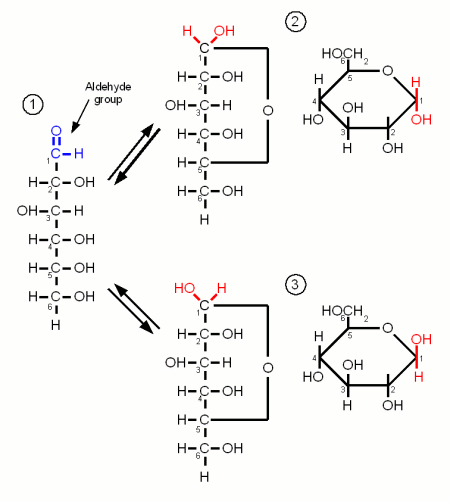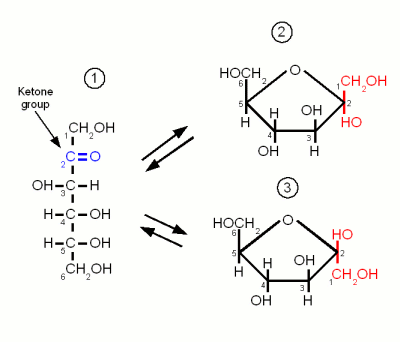Difference between revisions of "Carbohydrates"
(→Glucose) |
(→Fructose) |
||
| Line 23: | Line 23: | ||
==Fructose== | ==Fructose== | ||
[[Image:Fructose.gif|frame|right|Figure 2 - ]] | [[Image:Fructose.gif|frame|right|Figure 2 - ]] | ||
| + | |||
| + | Like glucose, fructose is also a hexose sugar but unlike glucose it is a ketose sugar because it has a ketone group as its carbonyl group. This group contains carbon 2 (instead of the carbon 1 that is included in glucose's aldehyde group) and as a result the ring that is formed by the oxygen atom of that group binding to carbon 5 has a pentagon shape in the Hanworth projection (Figure 2). | ||
<div style="clear:both;"></div> | <div style="clear:both;"></div> | ||
| + | |||
==Galactose== | ==Galactose== | ||
Revision as of 02:37, 14 December 2008
Carbohydrates are organic molecules that contain carbon, oxygen and hydrogen and are the most abundant organic compounds in nature. They serve as forms of energy source and storage and structural components for plants and some animals [Champe]. They have the basic formula (CH2O)n hence the name Carbohydrate or hydrate of carbon. Important carbohydrates in brewing are simple sugars (e.g. glucose, fructose), complex sugars (e.g. maltose, sucrose, maltotriose), dextrins and starches. But glucans, pectins and gums are also carbohydrates.
The following sections give insight into the structure of carbohydrates important in brewing. Some are more and others (e.g. lactose and sucrose) are less important in mashing but may be used at other places in the brewing process.
Monosaccharides
Monosaccharides are the simples carbohydrates and have the basic formula CnH2nOn. They are the building blocks of the more complex carbohydrates. The monosaccharides important to brewing, Glucose, Galactose and Fructose, are hexoses which contain 6 carbon atoms. They differ either in their carbonyl group or the orientation of the OH and H groups along the carbon chain. The carbonyl group is the group that contains the oxygen that is linked twice to a carbon atom. Either to the same carbon atom or tow different atoms from the same chain. Glucose and Galactose are adelose sugars and have an aldehyde group (Figures 1 and 3) as their carbonyl group and Fructrose is a ketose sugar and has a Ketone group (Figure 2).
Monosaccharides may exist in a open chain or in a ring configuration. But for monosaccharides with more than five carbons only less than one percent of the molecules will be in the open chain configuration. The rest is in the ring configuration. The rings are formed by the oxygen atom from the carbonyl group binding to another carbon atom of the chain.
By convetion the carbon atoms are numbered such that the highest numbered carbon is farthest away from the carbonyl (aldehyde or ketone) group.
Glucose

Glucose is by far the most important monosaccride in brewing. It is the building block for starch and thus produced during mashing. When the oxygen of the aldehyde group also binds to carbon atom 5 the molecule forms the ring typical for carbohydrates. The resulting molecule is called glucopyranose and depending on the orientation of the OH group on carbon 1 the molecule may be in the α or the β configuration. The difference is subtle but becomes important later when the glucose binds to other molecules to form more complex sugars. At this point α vs. β configuration becomes permanent and makes the difference between being convertible by mash and yeast enzymes or not.
But as long as the glucose molecule on its own both configurations coexist in an equilibrium and can change between the configurations by changing back to the open chain and back to the ring in the other configuration
Fructose
Like glucose, fructose is also a hexose sugar but unlike glucose it is a ketose sugar because it has a ketone group as its carbonyl group. This group contains carbon 2 (instead of the carbon 1 that is included in glucose's aldehyde group) and as a result the ring that is formed by the oxygen atom of that group binding to carbon 5 has a pentagon shape in the Hanworth projection (Figure 2).
Galactose
References
- [Valclavik] Vickie A. Valclavik, Elizabeth W. Christian, Essentials of Food Science, Third Edition, Springer
- [Champe] Pamela C, Champe, Richard A. Harvey, Denise R. Ferrier, Biochemistry, Lippincott's Illustrated Reviews
- types of sugar
- monosaccharides glucose, fructose, galctose
- disacchatrides maltose, succrose, lactose
- reducing/non reducing sugars
- where it is found
- glucose and 1-4/1-6 branches
- amylose
- amylopectin
- starch granule structure


